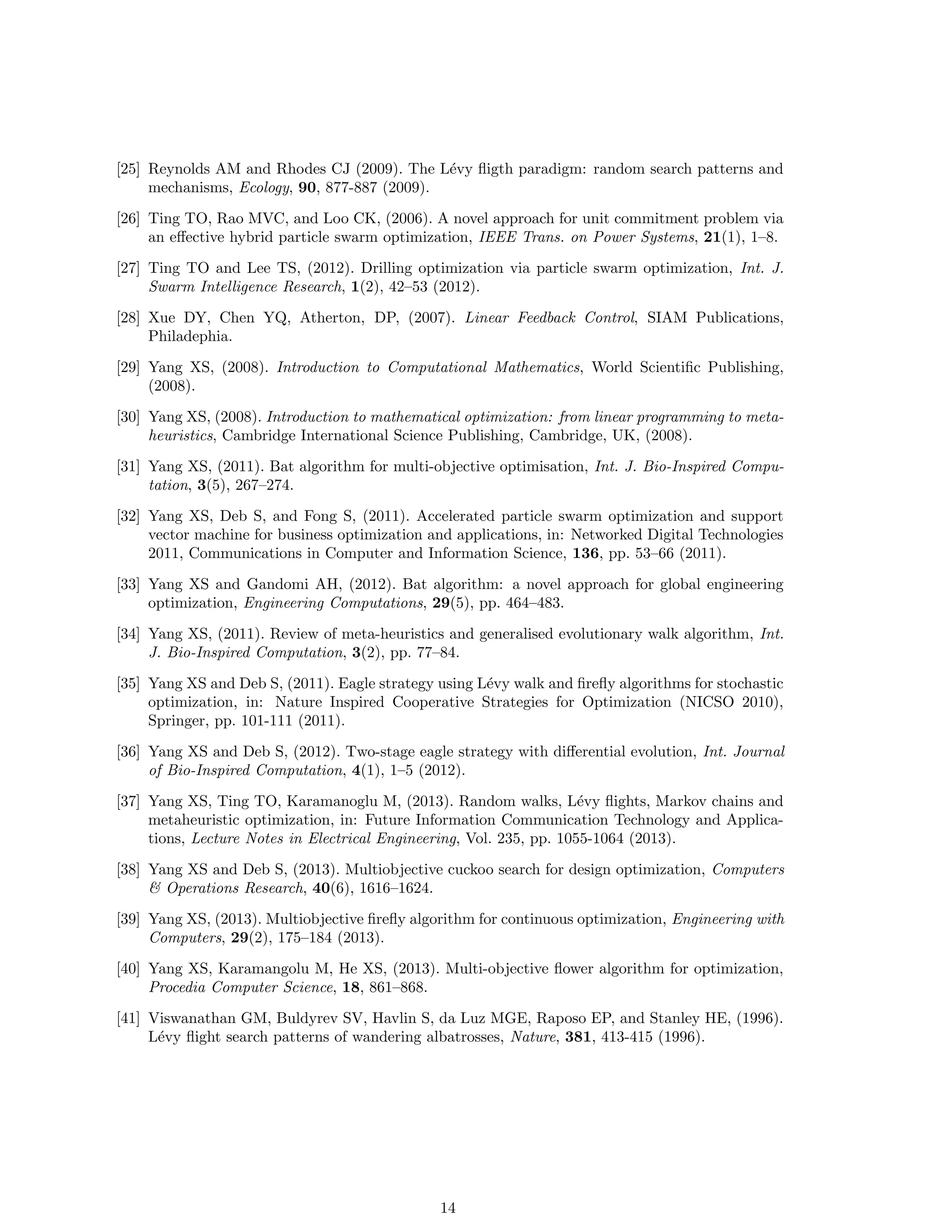This document discusses applying an eagle strategy inspired by nature to engineering optimization problems. The eagle strategy uses a two-stage approach combining global exploration with local exploitation. Global exploration uses Lèvy flights for random walks to diversify solutions. Promising solutions are then locally optimized using an efficient local search algorithm like particle swarm optimization. The document analyzes random walk models like Lèvy flights and how they can maintain diversity in swarm intelligence algorithms. It applies the eagle strategy to four engineering design problems, finding Lèvy flights can effectively reduce computational efforts.
![Applications and Analysis of Bio-Inspired Eagle Strategy for
Engineering Optimization
Xin-She Yang and Mehmet Karamanoglu
1 arXiv:1408.5320v1 [math.OC] 22 Aug 2014
School of Science and Technology, Middlesex University,
The Burroughs, London NW4 4BT, United Kingdom.
T. O. Ting
Department of Electrical and Electronic Engineering,
Xi'an Jiaotong-Liverpool University,
Suzhou, Jiangsu Province, P. R. China.
Yu-Xin Zhao
College of Automation, Harbin Engineering University,
Harbin, P. R. China.
Abstract
All swarm-intelligence-based optimization algorithms use some stochastic components to
increase the diversity of solutions during the search process. Such randomization is often repre-
sented in terms of random walks. However, it is not yet clear why some randomization techniques
(and thus why some algorithms) may perform better than others for a given set of problems. In
this work, we analyze these randomization methods in the context of nature-inspired algorithms.
We also use eagle strategy to provide basic observations and relate step sizes and search e-
ciency using Markov theory. Then, we apply our analysis and observations to solve four design
benchmarks, including the designs of a pressure vessel, a speed reducer, a PID controller and
a heat exchanger. Our results demonstrate that eagle strategy with Levy
ights can perform
extremely well in reducing the overall computational eorts.
Citation details: X. S. Yang, M. Karamanoglu, T. O. Ting and Y. X. Zhao, Applications and
Analysis of Bio-Inspired Eagle Strategy for Engineering Optimization Neural Computing and Appli-
cations, vol. 25, No. 2, pp. 411-420 (2014).
1 Introduction
In contemporary neural computing, an active branch of research is the nature-inspired algorithms
with diverse applications in engineering optimization. Most of these algorithms are based on the so-
called swarm intelligence, and usually involve some form of non-deterministic, stochastic components,
which often appear in terms of random walks. Such random walks can be surprisingly ecient when
combined with deterministic components and elitism, as this has been demonstrated in many modern
metaheuristic algorithms such as particle swarm optimization,](https://image.slidesharecdn.com/1408-141003105651-phpapp02/75/Applications-and-Analysis-of-Bio-Inspired-Eagle-Strategy-for-Engineering-Optimization-1-2048.jpg)
![re
y algorithm and other algorithms
[1, 18, 26, 29, 30, 32, 33, 34, 35].
Recent studies in nature-inspired algorithms have shown promising results with divers algorithms,
including new algorithms such as accelerated particle swarm optimization [32, 11], bat algorithm [33],
krill herd algorithm [10],
ower algorithm [40], and other algorithms [35, 26]. A comprehensive review
can be found in [5, 9, 38]. In all these algorithms, dierent degrees of randomization, exploration
and exploitation have been used so as to maintain a good degree of solution diversity in the solution
population, which helps to enhance the performance of these algorithms. Applications of modern
nature-inspired algorithms have been very diverse with promising results [5, 6, 27, 12, 31].](https://image.slidesharecdn.com/1408-141003105651-phpapp02/75/Applications-and-Analysis-of-Bio-Inspired-Eagle-Strategy-for-Engineering-Optimization-2-2048.jpg)
![In order to gain insight into the working mechanism of a stochastic algorithm, mathematical
analysis of the key characteristics of random walks is necessary. Though there are some extensive
studies of random walks with solid results in the statistical literature, most of these results are
based on rigorous assumptions so as to obtain theoretical results using Markov chain models and/or
Markov chain Monte Carlo methods [7, 8, 13, 14, 15, 29]. Consequently, such results may be too
theoretical, and thus have not much practical implications for designing optimization algorithms.
In addition, it is necessary to translate any relevant theoretical results in the right context so that
they are truly useful to the optimization communities. The current work has extended our earlier
work extensively [37]. Therefore, the aims of this paper are two-folds: to introduce the random
walks and Levy
ights in the proper context of metaheuristic optimization, and to use these results
in the framework of Markov theory to analyze the iteration process of algorithms such as step sizes,
eciency and the choice of some key parameters.
The rest of the paper is organized as follows: Section 2 brie
y introduce the eagle strategy (ES).
Section 3 introduces the fundamentals of random walks and discusses Levy
ights, as well as their
links to optimization via Markov chain theories. Section 4 analyzes the choice of step sizes, stopping
criteria and eciency. Section 5 presents four case studies for engineering optimization applications.
Finally, we brie
y draw the conclusions in Section 6.
2 Eagle Strategy and Solution Diversity
2.1 Eagle Strategy
Eagle strategy developed by Xin-She Yang and Suash Deb [35] is a two-stage method for optimiza-
tion. It uses a combination of crude global search and intensive local search employing dierent
algorithms to suit dierent purposes. In essence, the strategy](https://image.slidesharecdn.com/1408-141003105651-phpapp02/75/Applications-and-Analysis-of-Bio-Inspired-Eagle-Strategy-for-Engineering-Optimization-3-2048.jpg)

![nds a promising solution, then an intensive local search
is carried out by using a more ecient local optimizer such as hill-climbing and downhill simplex
method. Then, the two-stage process starts again with new global exploration followed by a local
search in a new region. The main steps of this method can be represented as the pseudo code as
outlined in Fig. 1.
The advantage of such a combination is to use a balanced tradeo between global search which
is often slow and a fast local search. Some tradeo and balance are important. Another advantage
of this method is that we can use any algorithms we like at dierent stages of the search or even at
dierent stages of iterations. This makes it easy to combine the advantages of various algorithms so
as to produce better results.
It is worth pointing out that this is a methodology or strategy, not an algorithm. In fact, we
can use dierent algorithms at dierent stages and at dierent time of the iterations. The algorithm
used for the global exploration should have enough randomness so as to explore the search space
diversely and eectively. This process is typically slow initially, and should speed up as the system
converges, or no better solutions can be found after a certain number of iterations. On the other
hand, the algorithm used for the intensive local exploitation should be an ecient local optimizer.
The idea is to reach the local optimality as quickly as possible, with the minimal number of function
evaluations. This stage should be fast and ecient.
For the local optimizer in this paper, we will use the accelerated particle swarm optimization
(APSO) [32] which is a simple but ecient variant of particle swarm optimization. The APSO
essentially has one updating equation
xt+1
i = (1](https://image.slidesharecdn.com/1408-141003105651-phpapp02/75/Applications-and-Analysis-of-Bio-Inspired-Eagle-Strategy-for-Engineering-Optimization-5-2048.jpg)
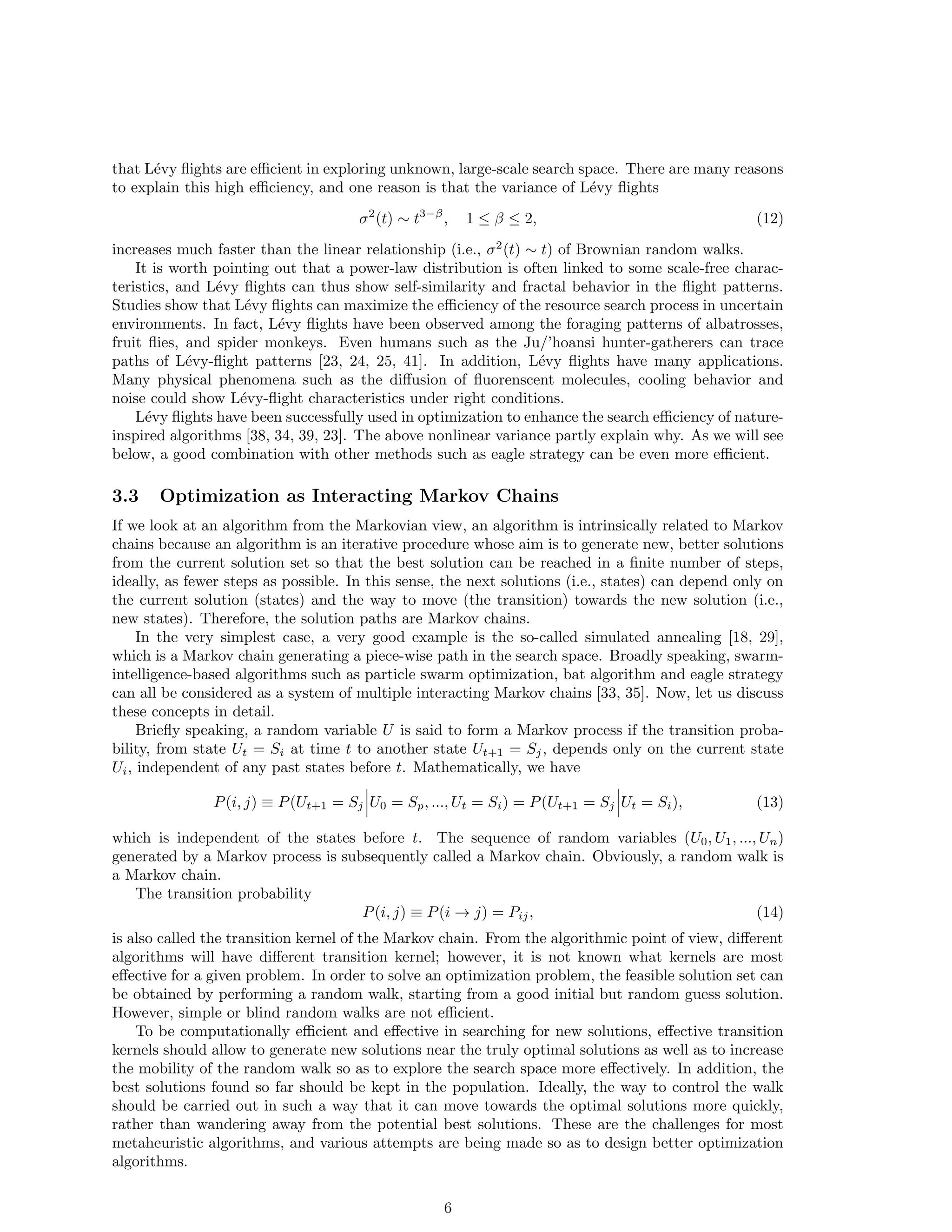
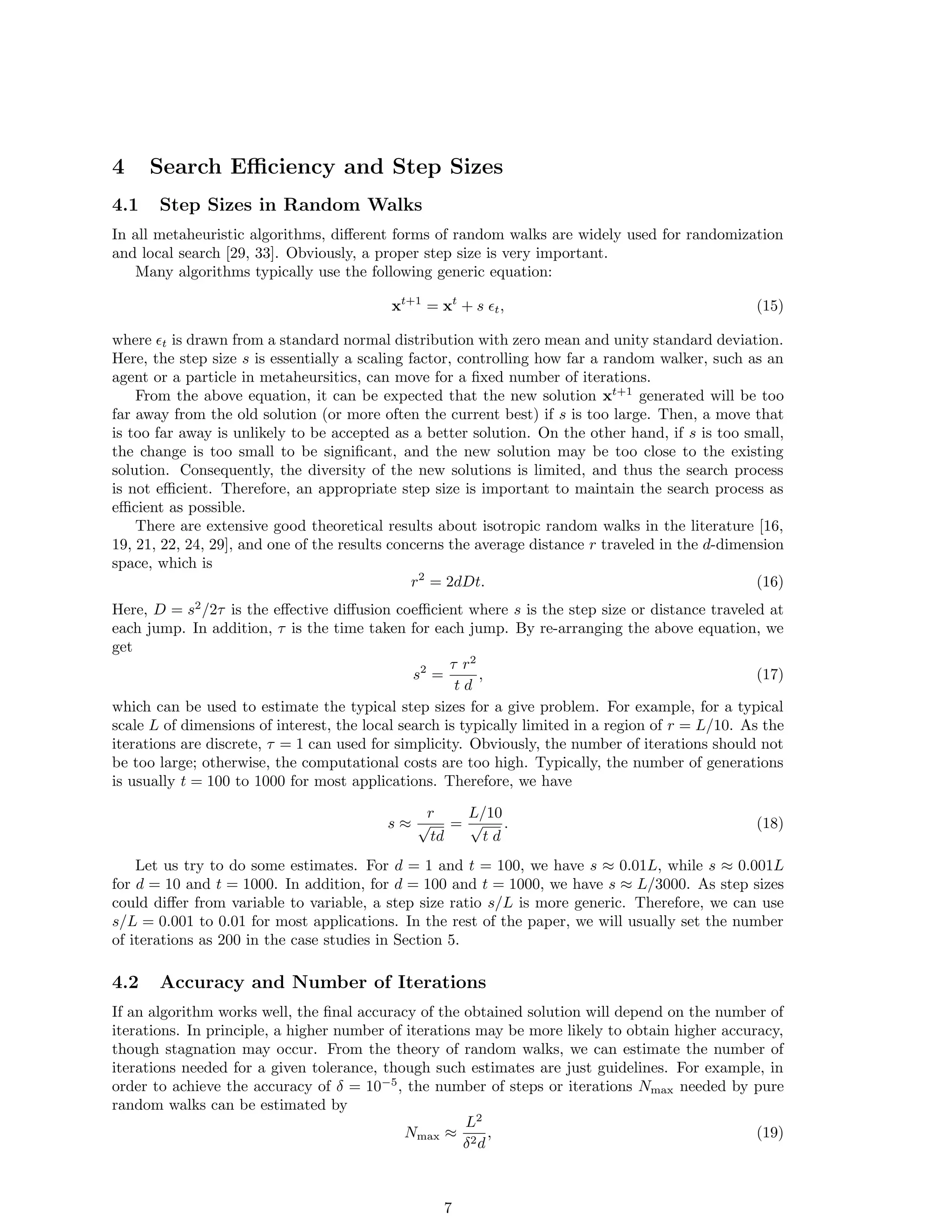
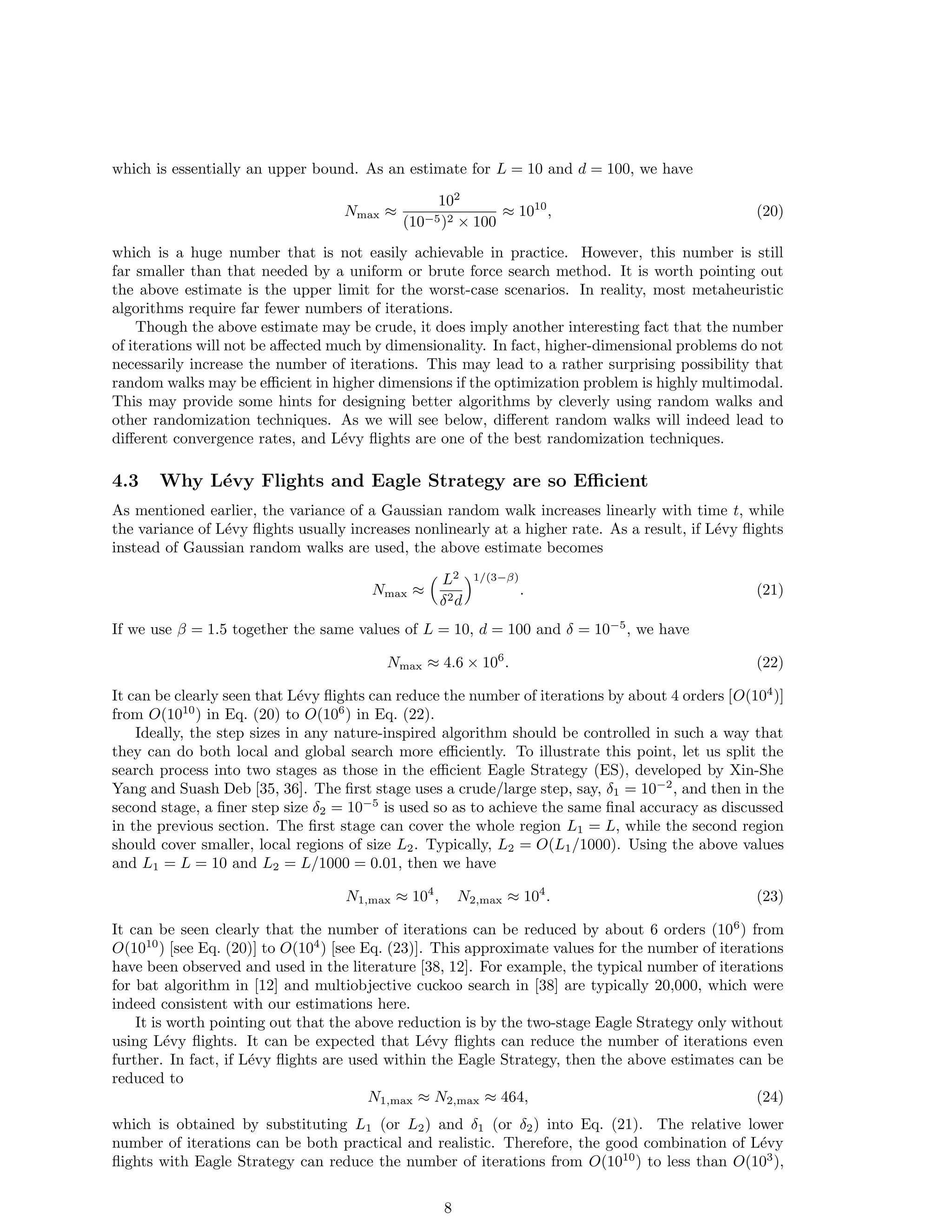
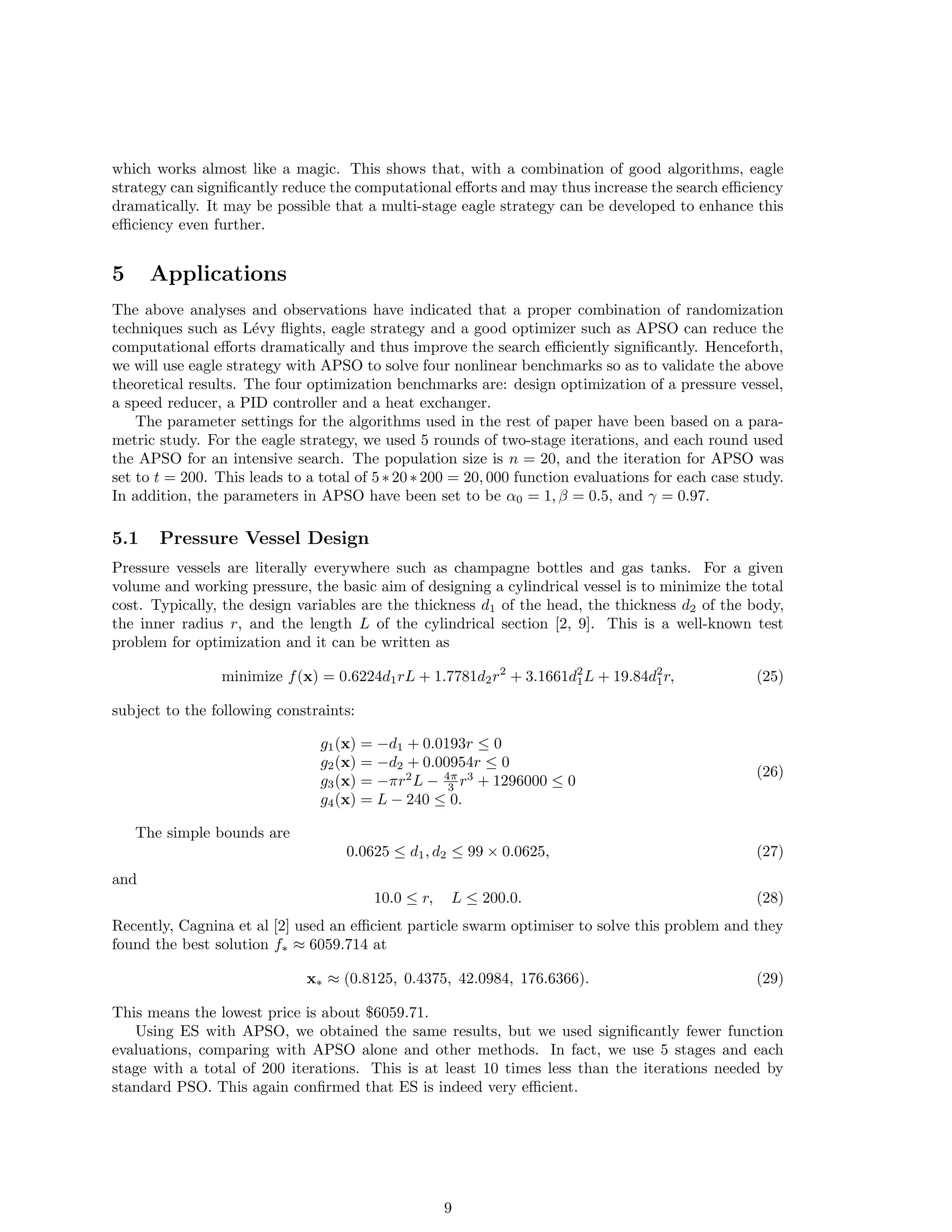
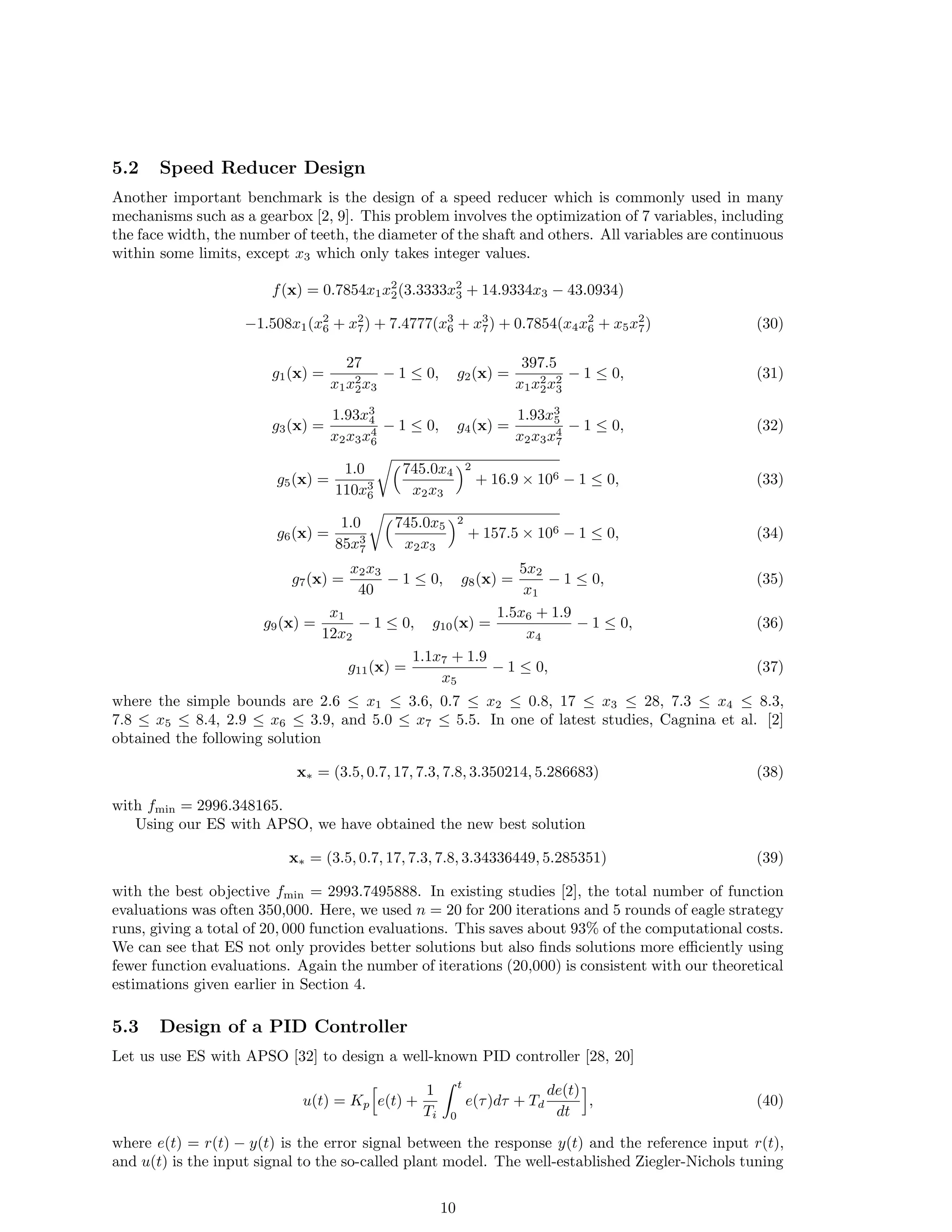
![= 0:5,
and
= 0:97 [32].
2.2 Exploration, Exploitation and Solution Diversity
In almost all nature-inspired algorithms, two con
icting and yet important components are explo-
ration and exploitation, or diversi](https://image.slidesharecdn.com/1408-141003105651-phpapp02/75/Applications-and-Analysis-of-Bio-Inspired-Eagle-Strategy-for-Engineering-Optimization-11-2048.jpg)
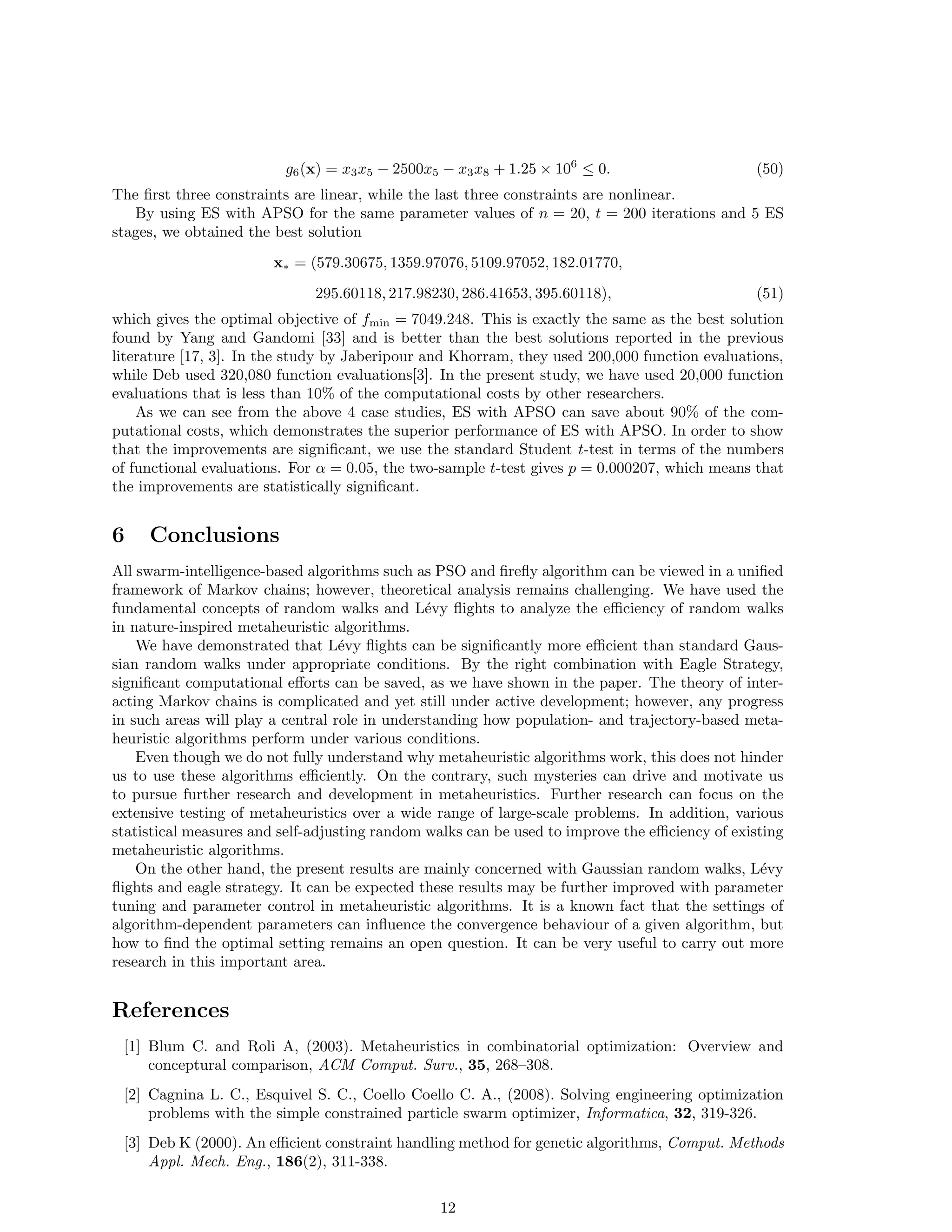
![cation. The balance between these components
are very important to ensure the good performance of an algorithm [1, 4]. In other words, a good
degree of diversity should be maintained in the population of the solutions so that exploration and
exploitation can be re
ected in the evolving population. If the population is too diverse, it is good
for global exploration, but it may slow down the convergence. On the other hand, if the diversity
is too low, intensive local exploitation may lead to premature convergence, and thus may loose the
opportunity of](https://image.slidesharecdn.com/1408-141003105651-phpapp02/75/Applications-and-Analysis-of-Bio-Inspired-Eagle-Strategy-for-Engineering-Optimization-13-2048.jpg)
